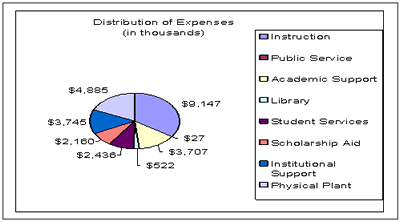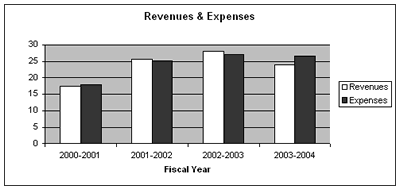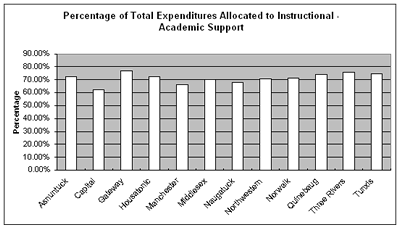9. Financial Resources
Description
Capital Community College is part of a statewide system of twelve community colleges. Within this system, the financial stability of the Capital Community College entity is dependent on the following sources of revenue: general fund, operating fund, grants and foundations, and bond funds.
The general fund for the College comprises its annual budget from the Board of Trustees of Connecticut Community Colleges, which has the authority to review and approve the funds of the community colleges’ as mandated in section 10a-72 of the Connecticut General Statutes (Exhibit 9.1). The College then allocates these funds by way of the budget process as described in the Budget Process section below. Any unexpended general funds lapse back to the State.
The operating fund comprises tuition and fees from credit and non-credit courses and from other sources such as continuing education courses, summer and winter session courses, bookstore revenue, facility rentals, and contracted services. The tuition funds are reallocated to the twelve colleges based on various formulas that take into account enrollment, existing staffing, historical fiscal data and college-provided cost estimates. The revenues collected from fees, contracts and non-credit course offerings are controlled by the individual colleges. The College receives grants from federal and state agencies as well as from private foundations such as the Hartford Foundation for Public Giving and the Capital Community College Foundation. The College also receives funding from the corporate community including the United Technologies Corporation, St Paul Travelers, and The Hartford.
Bond funds come from the Connecticut State Legislature, which appropriates funds to the College for capital expenditures such as building, building improvements, information technologies, equipment and other special projects.
Using the resources available, the College allocates funds to specific budgetary categories responding to the guidelines of the College’s strategic plan. The commitment of those resources among programs and services reflects the mission, goals, and priorities of the institution. As part of the annual budget process, the College earmarks projected discretionary revenues (such as interest earnings, facility rentals, and bookstore commissions) for unanticipated outlays. The set-aside of these revenues also ensures that the College has the financial ability to graduate all eligible students without interruption.
Financial and contingency planning at the College combine systemwide and local authority. The College does not have direct authority to raise tuition or fees for credit instruction, since such action is reserved by the Board of Trustees. The College does have authority to establish fees for non-credit instruction and services.
The College complies with Board of Trustees Operating Fund Policy (Exhibit 9.2), which states that Connecticut Community Colleges must maintain a contingency reserve fund for unanticipated, short term or one-time budgetary or cash flow needs. The fund must be equal to 4.5% of the total college prior year unrestricted expenditures from all sources, or $500,000, whichever is greater.
The expenditures of the College reflect its mission to promote student success by providing appropriate and adequate resources. Overall, 45 percent of expenditures are allocated for instructional and academic support. These expenditures include instruction (32%) and academic support (13%). Additional student support in the categories of student services (8%), library (2%) and scholarship aid (7%) increase the total allocation of academic-related expenditures to 62 percent.

Figure 1—Distribution of Expenses
In fiscal policies and procedures, the College adheres to regulations, policies, and statutes as prescribed by the State Comptroller, Board of Trustees and State Legislature. The Community-Technical College System uses BANNER as its integrated record keeping system. It includes a hierarchy of controls and access limitations. For example, student tuition and fee charges are calculated when students are registered by the Registrar’s Office and cannot be altered by the Bursar’s Office. Information is entered into a database once, preventing duplicative data originating from other offices, such as Admissions, Registrar, Financial Aid, Bursar, etc.
This system, along with state approved control procedures, ensures timely and accurate fiscal information. It includes an online approval process for purchase orders, although the requisition process is still manual. Budget versus expense information is available online in real time. The BANNER system flags as non-sufficient funds (NSF) any purchases or payments that exceed the budget, and only authorized approvers have access to override the NSF and complete the purchase order or approve payment of an invoice coded to an overspent budget organization code. To maintain fiscal controls, the business office prepares monthly budget/expenditure reports for all the college departments to review.
Capital Community College implements financial aid policies and practices that provide students the opportunity to apply for federal, state and institutional aid. The institution’s online information system allows students to access the Financial Aid Office at any time. Students can also attend regularly scheduled workshops or meet personally with an aid administrator. Many students who meet the eligibility requirements receive their aid awards prior to the beginning of a semester. This enables them to enroll for classes without having to take on an unnecessary financial burden. The number of students applying for and receiving financial aid awards is reviewed on a monthly basis. At the end of every year, the final data are analyzed to ensure the effectiveness of the policies and practices.
All constituencies of the College are involved in a budgetary process that implements the mission and objectives of the College within the financial framework of available funds. The budget process falls under the control of the Dean of Administration, who, after setting aside sufficient funding for fixed costs, analyzes budget authority requests for annual funding of operations. This information is compiled and presented to management for review and to the President for final approval. Each dean is ultimately responsible for the administration of his/her area’s budgets, with final authority resting with the President. Through the distribution of monthly budget/expenditure activity reports, those with authority to manage budgets are informed of the fiscal status of their respective areas. In addition, the Dean of Administration offers detailed expenditure analyses when requested by a budget authority. All fiscal policies and procedures are clearly documented on the systemwide website (Exhibit 9.3).
During the fiscal year covered by the budget, it may be necessary to increase and or decrease funding levels for an operational area. Such changes are initiated by the affected dean with a modification request, reviewed and approved by the President and immediately put into place. The President and deans have flexibility to react to campus situations and to take steps to ensure fiscal stability.
The College is audited annually by an external auditing firm in accord with the generally accepted auditing standards for colleges as adopted by the American Institute of Certified Public Accountants. Beginning fiscal year 2002, the System Office contracted with Price Waterhouse Coopers to audit the fiscal records of all twelve colleges as well as those of the System Office itself in order to assure compliance with the Governmental Accounting Standards Board. Prior to FY 02, the College reported financial information according to state accounting practices and was audited by the state Auditors of Public Accounts.
The Capital Community College Foundation is a Connecticut non-profit corporation that was chartered in May of 1985. Its mission is to support Capital Community College in all its endeavors. In 2001, the Foundation and the College’s Regional Advisory Council merged, and the joint mission and goals were revised to read as follows:
- Establish annual and long-term goals for institutional advancement.
- Raise funds for scholarships, facilities and equipment, books and educational materials, faculty and curriculum development.
- Serve as a prudent and effective steward of annual, endowment and capital gifts donated to the College.
- Increase awareness of the College and promote broad public participation in its educational, cultural and community activities.
- Advise and support the President in the development of credit and credit-free programs that are consistent with the goals of higher education in Connecticut.
- Advise and assist the Board of Trustees to meet the educational and training needs of business, industry and communities.
All gifts to the College, in accordance with Board of Trustees policies, are administered in accordance with donor intent and expended in support of the mission of the College. Gifts that are accepted by the College Foundation are additionally governed by Foundation procedures which require that donors’ restrictions be included in standard bookkeeping procedures. Based on donor specifications, as identified by the Foundation Chairperson, balances are recorded into two separate funds: restricted or unrestricted. The Foundation, in coordination with College personnel, provides reports to donors as requested on program results and accountability of funds.
Appraisal
The College has not lapsed any of the General Funds, and the College Operating Fund currently maintains the level of reserves as required by the Board of Trustees. When the College moved to its new location in 2002, it was necessary to expend reserves for the purchase of equipment and furniture. At the end of fiscal year 2003, the College had an unrestricted reserve deficit of $1.5 million. At the end of fiscal year 2004, the deficit was $983 thousand. By the end of fiscal year 2005, the College was able to eliminate the unrestricted reserve deficit completely, bringing it into compliance with the level of reserves as required by the Board of Trustees.
The College’s most recent audit indicated no significant weaknesses. There have been a few minor audit recommendations, and ensuing reports indicate that the recommendations have been followed.
A review of Capital Community College's financial resources must be seen within two contexts: the fiscal austerity that has permeated state government in the past several years, and the shift to enrollment-driven budgets that rely on student tuition and fees for operational funding. In these somewhat uncertain times in the State of Connecticut, the College continues to be financially sound and fiscally stable and solvent. However, a growing dependence on revenue from student tuition and fees leaves operations more vulnerable to fluctuation in enrollment than it has been in the past.
In recent years, the Continuing Education department has been able to contribute significantly to the revenues of the College. This allows the College to develop new programs and cover unexpected fiscal emergencies. The Continuing Education division added $1.1 million to total operating revenues for fiscal year 2004.
Revenues have generally kept pace with expenses, as illustrated in Figure 2 below.
Figure 2—Revenues and Expenses

As reflected in Figure 3 below, compared with the other eleven community colleges in the system, Capital allocates the smallest percentage of total expenditures to instructional and academic support. Part of this is the result of moving to the downtown campus, which has brought the College a significant increase in fixed plant costs related to parking and shared building use. In order to provide parking for all students, faculty and staff, the College purchases 500 parking spaces from the City of Hartford. The spaces have an annual administrative and maintenance cost of $342,000. In addition, shared building costs between the College and 960 Main Street include use and physical support for several areas of ingress and egress. These latter costs, currently $310,000 a year, are permanent and cannot easily be reduced without compromising the College’s image and its fulfillment of community responsibility.
Figure 3—Allocations to Academic Support

The BANNER system, which facilitates fiscal procedures, is an extensive, fully integrated administrative software package. Its hierarchy of controls provides security, and the system is procedurally effective and accurate. However, a weakness does exist in the area of reports. Gathering information for locally designed reports is cumbersome, and success often depends on the initiative and knowledge base of individual employees. Some reports must be accessed using multiple steps and may require compatible software such as Excel or Access.
The budget process has been changing over the past two years. With the relocation to a new campus and with increases in enrollment, the traditional model for budgeting on an annual basis has not functioned as well as it did in a more static environment. The traditional method of preparing annual budgets with minimum flexibility doesn’t meet the needs of a rapidly growing entity. As a result, the College has moved toward more dynamic and participatory budget development. Enabling departments to review expenditure budgets on a monthly basis allows flexibility to address fluctuating trends. This action ensures maintenance of a satisfactory fund balance, and it provides an informative guide for administrative decisions on reappropriations among operating budgets in response to unforeseen needs of the College. Also, individual departmental needs can be addressed in a timely manner.
Projection
To respond to a recent rise in tuition receivables, the College has been rigorously enforcing a systemwide policy requiring the payment of all college fees upon registration. The College deregisters students who do not pay all applicable college fees within 24 hours of registration. Deregistering a student removes the receivable from the student’s account as well as the College’s tuition receivable. Also, staff in the Registrar’s and Business Office are making every attempt to contact students who have not made payments to try to work out payment arrangements.
The College will continue to maintain control of the General Fund resource so that no funds are lapsed. Currently, The College’s reserve balances are at an acceptable level. It is anticipated that the revenue base will increase, but in the meantime, the College monitors the reserve levels carefully and approves use of these funds selectively.
By applying a conservative spending policy without sacrificing programs and student support services, the College expects to maintain its positive unrestricted net asset balance and remain in compliance with the Board of Trustees Operating Fund policy guidelines.
In an effort to increase the percentage of total expenditures allocated to Instructional and Academic support, the College will continue to perform cost containment activities such as reviewing the energy management system to control room temperatures and reduce light usage.
he College will continue to involve all constituencies in the budgetary process and will ensure that budgets respond to the needs of the new strategic plan.
large percentage of the College’s budget depends on revenue from the State of Connecticut, which funds numerous agencies, of which the community college system is but one. When the state funds decline, so does the College’s allocation. While state funding appears to have stabilized, it is expected that state appropriations will be rolled over at current levels. Therefore the College will utilize other funding sources, such as non-credit tuition, grants, and the Foundation to provide continued growth and enhancements.
The College continues to compete aggressively for state and federal grants. Working from a planning grant in 2005-2006, the College has completed an application to the American Association of Community Colleges and the Lumina Foundation for an Achieving the Dream grant. This grant would provide $100,000 a year for four years to be used for research-based initiatives addressing gaps in student achievement.
State and private grant revenues increased by over $126,000 in fiscal year 2005, up 10.6%. This increase comes largely from two sources: a $75,000 grant award from the State Department of Higher Educationto subsidize the College’s new evening nursing program; and a $27,000 increase in the Connecticut Aid to Public Colleges need-based financial aid program. The College also received a $6,000 grant from the State Office of Policy Management for an energy conservation project to upgrade the energy management system in an effort to reduce utility usage. A $6 million state bond for campus expansion is moving through the approval process and is expected to be made available in the coming year. As the campus expands, grants will continue to provide the initial funding path to meet new instructional and student programmatic needs.
The endowment drive goal, set with the federal matching funds as a part of revenue projections, has been established at $1,000,000 with an end date of June 30, 2007. The Foundation’s executive and finance committees have taken steps to increase the earnings of endowments through investments that are liquid and low risk yet provide a higher annual yield than that derived from money market funds at the banking institution used by the Foundation.
In tandem with endowment growth and management, the Foundation seeks to increase the level of annual funds raised for more immediate needs at the College through annual appeals and other fund-raising activities. The addition of new unrestricted revenues from expanded Foundation efforts will make it possible for the College to address needs that are currently unmet through annual operating funds.
In addition, the President has identified the need to fund new initiatives and programs that cannot be sustained by state appropriations or tuition revenue alone. The President will ask the Foundation to undertake a capital campaign within the next two years to raise funds for College priorities and initiatives that are being developed through the strategic planning process.
Exhibits
|

